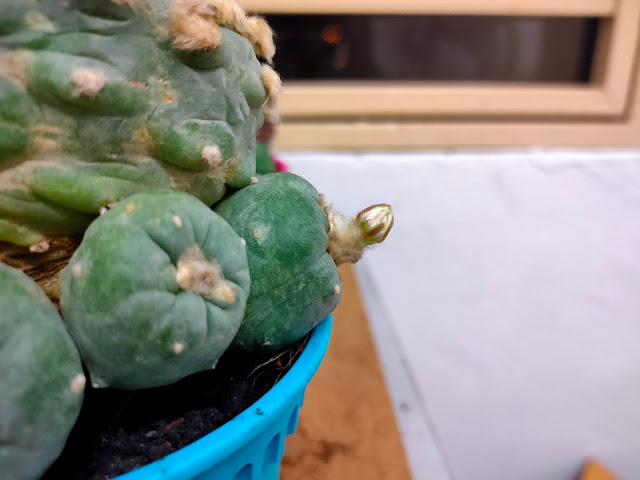The Peyote Cactus
Basic Information
Origin
and Habitat: Grows in
an area that stretches from from the Chihuahuan Desert to the South Texas
Plains, on either side of the middle and lower Rio Grande River, southward to
the Mexican states of Chihuahua, Coahuila, Durango, Nuevo León, San Luis
Potosí, Tamaulipas, Zacatecas. Extensive stands of peyote occur on the low, rocky
hills in Starr, Zapata, Webb, and Jim Hogg counties of southern Texas.
Altitude: It grows from 100 up to 1900 metres
above sea level.
Habitat
and Ecology: This
geophytic, button-like cactus occurs in xerophyllous scrub including Tamaulipan
thorn scrub isolated or in groups usually in calcareous deserts, on rocky
slopes, or in dried river beds. The species is very abundant in habitat with
large number of mature individuals however many subpopulations of Lophophora
williamsii are heavily harvested in the wild throughout the range of the
species, some to the point of extirpation. In Mexico, collection is illegal and
people are punished for collecting it. Land use change for agriculture is a
significant threat, as the land is completely ploughed, thus eliminating all
vegetation including L. williamsii and its seed bank.
Description: Lophophora williamsii is a solitary or (rarely)
caespitose, spineless cactus, normally unicephalous but becoming polycephalous
with age or injury.
Stem: Glaucous green, dull bluish or greyish green, very
succulent, globular, top-shaped, or somewhat flattened up to 6 cm tall, 12 cm
diameter, with a woolly top; The subterranean portion of the stem, which is as
wide as the aerial portion, extends several cm below the surface of the ground
and transitions smoothly (through a thin hypocotyl) into a large taproot which
may extend over 25 cm below ground level.
Ribs: (5 when young) 7 to 13 (very rarely 4 or 14 ) broad,
rounded, straight, or spiralled, often tuberculate, sometimes irregular and
indistinct, with transverse furrows forming more or less regular, polyhedral
tubercles;
Roots: Napiform, usually 8-11 cm long
Areoles: Round spineless, bearing flowers only when young with
some bunches of long erect, matted, wooly greyish hairs, up to 1 cm long.
Flowers: Solitary, campanulate, 1.5-2.5 cm across when open usually
pink (rarely whitish) outer perianth segments and scales ventrally greenish.
They emerge from the mass of hairs at umbilicate center of crown each
surrounded by a mass of long hairs. Stigma-lobes 5-7, linear, pink.
Blooming season: Flowers sporadically throughout summer.
Fruits: Club-shaped, red to pinkish, 2 cm long or shorter which can
be very delectable and sweet-tasting when eaten.
Seeds: Small and black up to 1 mm in diameter, with broad basal
hilum, tuberculate-roughened.
Growing Guide
Cultivation and Propagation: All Lophophora species are extremely slow growing, often
taking up to thirty years to reach flowering age in the wild (about the size of
a golf ball, not including its root). Human cultivated specimens grow
considerably faster, usually taking from six to ten years to go from seedling
to mature flowering adult.
Because of the tap root they are very rot prone, so use
highly gritty compost with much drainage. Requires half shade to part sun.
Watering should be rather infrequent to keep the plant compact and not to
become excessively elongated and unnatural in appearance, watering it properly
is often difficult because this plant tends to crack open or rot if
over-watered. The fact that the plant retracts into the soil and assume a
grey-green coloring between watering, is perfectly natural and doesn’t cause
any damage.
Overwatering: Keep completely dry and cool in winter (An unheated
greenhouse would be perfect) or when night temperatures remain below 10° C, it
can survive low temperatures (appr. -7°C) for a short period. Assure a good
ventilation.
Propagation: Easy to propagate from seeds. The seeds are, requiring
hot and humid conditions to germinate.
Uses: Peyote has been used for centuries for the mystical
effects experienced when it is ingested. It contains a large spectrum of
phenethylamine alkaloids, the principal of which is mescaline. The top of the
cactus that grows above ground, also referred to as the crown, consists of
disc-shaped buttons that are cut from the roots and dried. These buttons are
generally chewed, or boiled in water to produce a psychoactive tea. The
resulting infusion is extremely bitter and, in most cases, the user experiences
a high degree of nausea before the onset of the psychedelic effects.
However cultivated plants have only traces of the alkaloid
present in wild harvested plant and their “psychedelic” effect are minimal or
completely absent, but they still cause nausea, vomit, headache.
Images
15 Jan 2020
15 Jan 2020
Interested in buying them cheaply?
Thanks for reading guys,
Dont forget to subscribe









































No comments:
Post a Comment